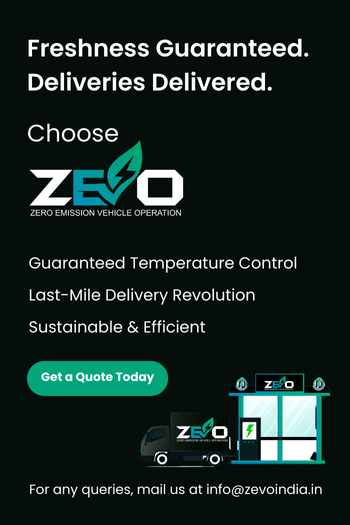Electric vs. Petrol Vehicles: Which is Better for Food Delivery?

Akshay Sharma
CEO's Office @ZEVO
With the rapid growth of food delivery services in India, choosing the right vehicle is crucial for minimizing costs and maximizing efficiency. Electric vehicles (EVs) for food delivery in India are gaining traction due to their lower operational costs and environmental benefits compared to petrol-powered vehicles.
This blog explores the pros and cons of EVs vs. petrol vehicles for delivery, focusing on cost, efficiency, maintenance, environmental impact, and the innovative ZEVO EV-as-a-Service model.
Cost Comparison: Electric vs. Petrol Vehicles for Delivery
Electric Vehicles (EVs)
Is it cheaper to use electric vehicles for food delivery in India? Yes, electric vehicles are more cost-effective than their petrol counterparts. The cost of running an EV is as low as ₹1 to ₹1.5 per kilometer, compared to ₹2 to ₹3 for petrol vehicles. For instance, a food delivery service operating 1,500 kilometres monthly would spend around ₹2,300 on fuel for an EV, versus ₹3,000 or more for a petrol vehicle. Over time, this cost difference can lead to significant savings.
Moreover, the government incentives for electric vehicles in India, such as subsidies and tax benefits, further lower the initial investment. The electric vehicle subsidies for businesses in India make EVs an appealing choice for companies looking to cut costs.
Petrol-Powered Vehicles
Petrol vehicles have higher operational costs due to fluctuating fuel prices. With petrol prices around ₹102 per liter, the fuel costs add up, especially for businesses with high delivery volumes. Additionally, petrol vehicles for delivery are more prone to rising costs from emissions regulations and potential congestion charges in urban areas, increasing their overall expenses.
Food Delivery Vehicle Efficiency in India: EVs vs. Petrol
Electric Vehicles
Electric vehicles offer superior energy efficiency due to fewer moving parts and no reliance on internal combustion. Most electric two-wheelers for food delivery routes can cover 80 to 100 kilometers on a full charge—perfect for urban settings. The electric vehicle benefits for delivery services include lower energy consumption and reduced need for frequent recharging in city traffic.
Petrol-Powered Vehicles
While petrol vehicles can cover longer distances without refuelling, they are less efficient regarding fuel consumption. This inefficiency results in higher fuel costs over time. For businesses considering the best vehicles for food delivery in India 2024, EVs are a more sustainable and cost-efficient option.
Performance Comparison: Electric Two-Wheelers vs. Petrol Bikes for Food Delivery
Fuel Efficiency and Range
Electric vehicles achieve operational costs as low as ₹1-1.5 per kilometer, while petrol bikes range between ₹2-3 per kilometer. The food delivery vehicle efficiency in India favors EVs for their cost-saving potential over time. However, petrol bikes for delivery offer longer ranges of 300-400 km per tank compared to 80-100 km for electric delivery scooters in India.
Torque and Acceleration
While petrol engines offer higher torque and better acceleration at lower speeds, electric two-wheelers for food delivery routes deliver instant torque, which translates to quick acceleration. Despite the added weight of batteries, EVs offer performance comparable to petrol bikes, especially in stop-and-go city traffic.
Maintenance Costs of Electric vs. Petrol Bikes for Delivery Services
Electric Vehicles
Electric vehicles produce zero tailpipe emissions, drastically cutting down air pollution and greenhouse gases associated with food delivery. As India transitions to a greener grid with renewable energy sources, the environmental footprint of EVs will continue to shrink. Zero-emission vehicles for delivery are becoming a priority for environmentally conscious businesses.
Petrol-Powered Vehicles
Petrol vehicles emit significant CO2 and pollutants, contributing to urban air quality issues. Businesses using petrol vehicles face increasing regulatory pressures to reduce emissions, making the shift to electric vehicles inevitable for sustainability and cost savings.
ZEVO: A Game-Changer in the EV-as-a-Service Model for Food Delivery
ZEVO is leading the charge in India’s electric vehicle sector by offering a flexible EV-as-a-Service model for food delivery. This model simplifies the adoption of EVs by handling all aspects, from maintenance to charging infrastructure, enabling businesses to focus on core operations without the headaches of fleet management.
Key Benefits of ZEVO’s EV-as-a-Service Model
- Convenience: ZEVO manages all aspects of EV usage, including charging and maintenance.
- Cost-Effectiveness: The subscription-based model eliminates high upfront costs associated with purchasing EVs, reducing overall operational expenses.
- Sustainability: Using ZEVO’s electric vehicles aligns with the demand for sustainable practices.
- Data-Driven Insights: ZEVO offers valuable analytics on charging, route optimization, and vehicle performance, helping businesses make informed decisions.
Conclusion: Electric Vehicles are the Future of Food Delivery in India
In conclusion, electric vehicles for food delivery in India provide significant advantages over petrol vehicles, including lower operational costs, reduced maintenance, and a smaller environmental footprint. While petrol vehicles still have an edge in range and initial acceleration, the benefits of EVs—especially with innovative solutions like ZEVO’s EV-as-a-Service—make them the preferred choice for food delivery services aiming for cost-efficiency and environmental responsibility in 2024.

Share this Article
Subscribe to our newsletter
Be the first to receive exclusive offers and the latest news on our products and services directly in your inbox.
